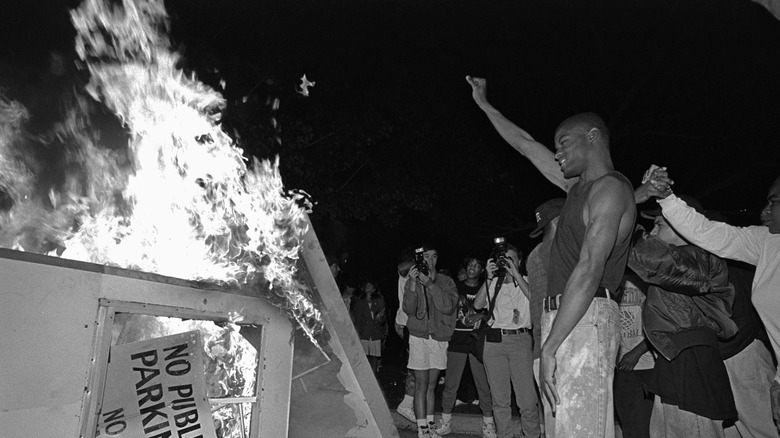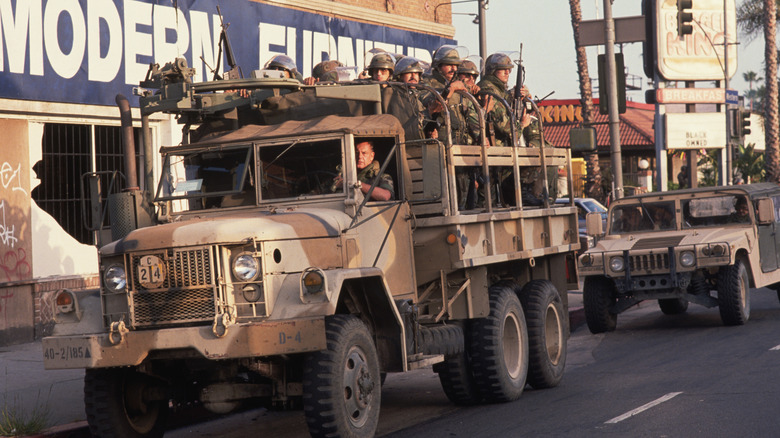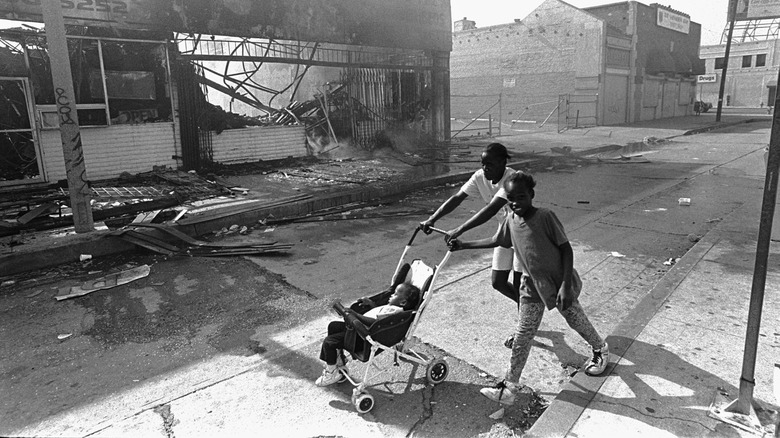Why The Insurrection Act Was Last Used For The 1992 LA Riots
Rodney King had been drinking on the infamous night in 1991 when he was pulled over and severely beaten by four members of the Los Angeles Police Department. He was also on parole, but he had a steady job to get back to the next morning. In an interview with and told NPR, King said when he saw a police car behind him as he drove from a friend's house, he just wanted to get away so he didn't get in trouble and could get to his job the next morning. When they finally caught him and got him out of the car, they beat and kicked King so severely that they broke his bones, his teeth, and fractured his skull. He was left with permanent brain damage.
A bystander caught the brutal beating on video, and soon it was posted all over news outlets around the nation. The officers were charged with using excessive force but all were acquitted on April 29, 1992. Three hours later, as night fell, outraged people took to the streets and began what would become a six-day riot in which 63 people were killed and the city suffered $1 billion in property damage, as the LA Times reported.
Considering the people were railing against the LAPD, the contention was palpable. For inexplicable reasons, the police ignored calls for help and didn't respond to the unrest for around three hours after it was first reported. In the hours and days that followed, the situation was so dire that California Gov. Pete Wilson deployed the National Guard. He and LA Mayor Tom Bradley also appealed to President George H.W. Bush to invoke the Insurrection Act. Bush complied, telling the American people that the behavior of the rioters wasn't about civil rights, upholding equality, or protesting (via YouTube). Rather, it was the "brutality of a mob, pure and simple," and he "would use whatever force is necessary to restore order." That force was the military.
What is the Insurrection Act?
The Insurrection Act is often called the Insurrection Act of 1807, but it was actually enacted in 1792. Composed of several statutes Congress enacted between the year it was created through 1871, the legislation allows the president of the United States to send in the military in a law enforcement role to police the citizens of the U.S. This is forbidden by another Act — the Posse Comitatus Act, which bans military forces from involvement in civilian law enforcement matters.
The Insurrection Act is typically reserved for extreme situations, such as the 1992 LA riots, but it's written very broadly — too broadly, in some views. It essentially allows a sitting president to send in the troops as they see fit. Technically, the law states that things like "rebellion," "domestic violence" and "insurrection" are cause to invoke the Insurrection Act, but definitions of those terms are not included in the text, as Brennan Center for Justice explains, leaving room for subjectivity.
The Insurrection Act has not been invoked since 1992, the longest the U.S. has ever avoided using the military as backup for law enforcement. The reason is likely that no president has faced such a calamitous event. In that scenario, people were angry and energized by injustice. Rediscovering Black History explains those living in what was then called South Central LA had endured years of "economic decline," police brutality, and racist policies that made it hard to find jobs and homes. The Rodney King verdict was the final straw (though two of the accused were eventually charged and sent to prison — here's what happened to the police officers afterward).
The Insurrection Act helped end the riots
To quell the violence, a joint task force formed. Approximately 4,000 U.S. Marine and Army troops and 1,000 more federal officers went to LA in what was dubbed "Operation Garden Plot." With the influx of the military helping to police the city, the riots finally came to an end after nearly a week. On May 4, the curfew was lifted, and businesses that still stood reopened. According to NPR, roughly 1,000 buildings were "damaged or destroyed," along with 2,000 businesses run by Korean families, as there had been ongoing tensions between that community and the African-American community. Over time, the area was cleaned up and people went on with their lives, but the riots went down as a historical event.
Even with the nationwide George Floyd protests — prompted by a video of a Black man being killed by a white police officer in 2020 — no uprisings in the U.S. have been as violent, deadly, or destructive as was the 1992 LA riots. And yet, due to the broad language in the Insurrection Act, military force may be yet again invoked by President Donald Trump as a means of law enforcement. On January 20, 2025, he wrote a declaration about the emergency at the southern border of the United States. Within 90 days, Trump said, would decide whether to invoke the Insurrection Act there so that the U.S. military can work in a law enforcement role to combat "cartels, criminal gangs, known terrorists, human traffickers, smugglers, unvetted military-age males from foreign adversaries, and illicit narcotics." If he does so, it would be a new interpretation of how the Insurrection Act can be used. Of course, as Live Fox Now points out: "Almost anything and everything is on the table during a Trump presidency."


